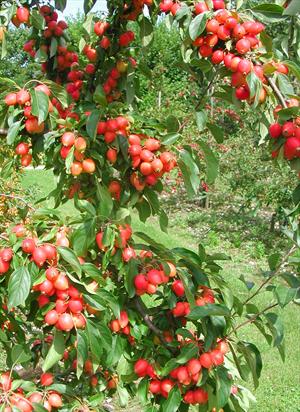Crab Apple Juice

John Downie
For this purpose crab apples may be divided into three categories:
1. Cultivated ornamentals, such as John Downie.
2. Our native crab - small bright green apples, bitter as gall which eventually turn yellow when ‘ripe’.
3. Wildings - which have probably grown from discarded apple cores. They come in all types and sizes, but generally resemble smallish, third rate cooking apples.
Some of the most unpromising looking apples proved, when pulped, to have a delightful aroma. John Downie when fully ripe can be positively perfumed. But the biggest surprise was the original gravity of the juice. In no case was it less than 1050, the majority was over 1055 and some exceeded 1060. This implies a soluble solid content of 14-16% and, if the juice be fermented into dry cider, an alcohol potential of 6% plus.
Palatability of juice varied enormously. John Downie was highly flavoured and very acceptable on its own. That of wildings was usually sharp and tangy - perhaps too much so for some people - but very refreshing. Juice of native crab is too astringent for most tastes but can be mixed with that of bland eating apples to make an excellent drink.
Juice extraction from crab apples generally was not so good as that from the majority of varieties where, if a press was used, 60% to 80% may be obtained. Crab apples tend to yield no more than 50%.
Turning to cider, both cultivated ornamentals and wildings may be included with other varieties in more or less any proportion. Native crab should be a minority in the mixture and perhaps best balanced with a similar quantity of eating apples.
If you have crab apples at your disposal, and are interested in producing fresh juice or cider, please try them. I do not think you will be disappointed.
Jim Streeton
Reproduced with permission from Fruit News, Summer 1998
Published: 20-Nov-07
Author: Jim Streeton
To comment on this article please visit our blog.
